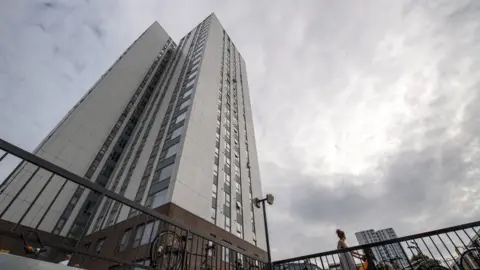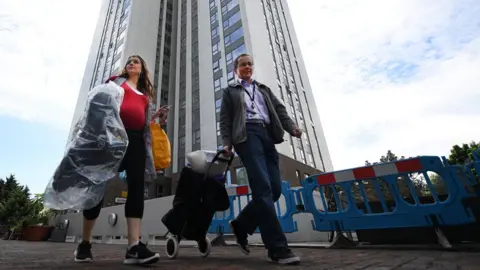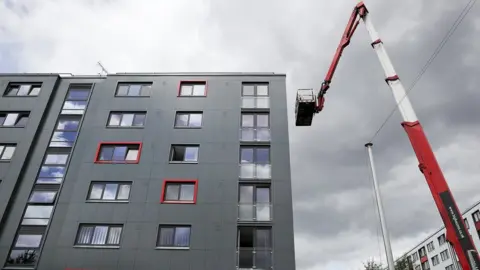Why do England's high-rises keep failing fire tests?
 Getty Images
Getty ImagesOver the past week, the government has been testing high-rise tower blocks in England owned by councils and housing associations. All 95 of those tested so far have been discovered to be covered with an aluminium "rain-screen" exterior cladding that does not meet the required combustibility standards. You would be right to ask: how on earth can this have happened?
The short answer is: the organisations responsible for maintaining standards in the building industry have been advising contractors not to take the regulations too literally.
To understand this, it is worth starting with a document known as Approved Document B. This is the government's own set of fire safety guidance. It stipulates, at section 12.7, "in a building with a storey 18m or more above ground level any insulation product, filler material.... etc used in the external wall construction should be of limited combustibility".
That loose-sounding term - "limited combustibility" - actually has a precise definition, set out later in that document. Broadly, though, all you need to know it basically won't catch alight. And material meeting this requirement in tests will get a combustibility grade of "A2" or better.
That is the standard against which the government has been testing cladding. A government spokesperson said "a test failure means that the cladding does not meet the requirements for limited combustibility in current Building Regulations". That is to say, a failure means a breach of the official rulebook.
Why, then, have builders installed so much sub-A2 cladding?
 Getty Images
Getty ImagesUndermining the building regulations
The first thing to know is that local officials no longer run all building inspections. England has a so-called "Approved Inspector" regime. Contractors must no longer wait for a local authority official to check their work. Instead, they may hire people to check their construction processes meet the required standards. There is no single regulator - or arm of government - directly upholding standards.
Second, the most important requirement in the building regulations is to build a safe building. So long as you do that, the fine print of the rules does not much matter too much. That is why, when inspectors sign off sites, they do not feel the need to work directly from the government's own guidelines. And the guidelines set out by government are rather old, and cannot specify everything in all circumstances.
That has left a gap into which esteemed sector bodies have stepped. Their umbrella organisation - the Building Control Alliance (BCA) - has issued advice about how to get a building signed off as compliant without using the type of materials specified in the government guidelines.
And it is the case that, in the event of some prosecutions or a civil case, breaching the government's guidance would count as a serious strike against a builder. But it would also be the case that following widely accepted professional practise and BCA guidance may also constitute a defence in a suit for negligence and grounds for mitigation in a criminal prosecution.
The problem is that this BCA guidance does not just suggest ways of making new technology fit the old rules. It introduces loopholes. The net effect of the sector bodies' guidance is to set weaker standards than the government's rulebook.
Routes to compliance
For example, the BCA's guidance in force when the Grenfell renovation took place was issued in July 2014, and it stated that there were several routes to getting a building ready for sign off by an inspector. "Option 1" was just to follow the simple Approved Document B route: just make sure everything you bolt to the outside of the building is of grade A2 or better.
There were other routes, though, to allow the use of sub-A2 components. Option 2 is to hold a bespoke fire test. So you rig up a wall in a test centre with your proposed cladding design - which might include some sub-A2 components - and try to set it on fire. If it passes the test, you can get certified so that inspectors will sign off this system, even if component parts on their own would not pass.
This route is actually referred to within the official guidance and has a clear performance standard attached. But there are issues with this. For example, we do not know how many attempts a product might take to pass a fire test.
Option 3 is where bigger concerns creep in. It allows for so-called "desktop studies". If I have conducted tests of a cladding product in a few different scenarios, then I might not need to bother with a new fire test. I can convince inspectors to sign it off by hiring an expert who will say "based on these results, I am confident that this cladding is safe in this context" without doing any further trials.
There are problems with all of this: it has allowed substandard material through. It is a deeply opaque process. We do not know when desktop studies get used. We do not know who writes these desktop studies. They are not lodged anywhere so that people living in these buildings can go and check on them.
 Getty Images
Getty ImagesA long way below A2
Newsnight reported, however, on a troubling fourth route. The National House Building Council (NHBC) is a big player in building inspection. Last year, they issued guidance which states that you can use a variety of sub-A2 insulation boards with B-grade external cladding - and you can do all of that without even a desktop study.
That effectively means that a sector body involved in signing off buildings unilaterally decided that largely using B-grade material is now sufficient, not A2. NHBC themselves state that "this is on the basis of NHBC having reviewed a significant quantity of data from a range of tests and desktop assessments."
NHBC also added: "we are confident that since the guidance note was issued, the inappropriate use of [plastic-core panels] would have been identified. Indeed we have not encountered or approved any proposals for their use via this route since this guidance was issued in September 2016."
But they have conceded there is at least one such polyethylene-core cladding product that meets the B-grade standard demanded in their guidance. And following Newsnight's reporting on this guidance, the body said that "in light of on-going discussions regarding the use of [plastic-core cladding] products in high-rise buildings, NHBC has withdrawn its guidance".
Plastic-core panelling is not the only issue, however, with the now-suspended guidelines.
NHBC also advised that materials could be used more widely than their own manufacturers did. Take one of the insulation materials that the NHBC mentioned by name: Celotex RS 5000, the insulation used at Grenfell Tower. According to documents issued by the manufacturer, this board was only tested for use with A2-grade external cladding. The NHBC said it could be used with B-grade cladding,
We also identified one type of insulation that, NHBC said. could be used safely with B-grade cladding, which is actually grade C. All in all, the NHBC guidance was a long way from that official A2 standard.
As the official cladding tests results keep showing, though, NHBC are hardly alone in having signed off sub-A2 cladding. These widespread test failures are a symptom of broader problems with standards across our building sector.
There has been a lot of discussion about sprinklers. But the catastrophe at Grenfell Tower has showed up the weakness of the whole framework in which our building regulations sit. The basis on which we decide whether a tower block is fire-safe is a mess.
Accepted professional practice has systematically reduced the fire resistance of our tall buildings.